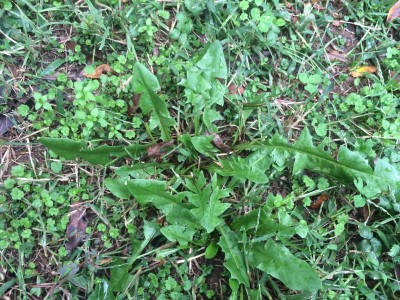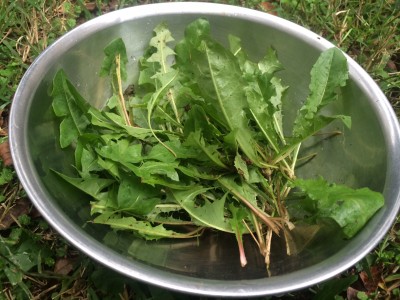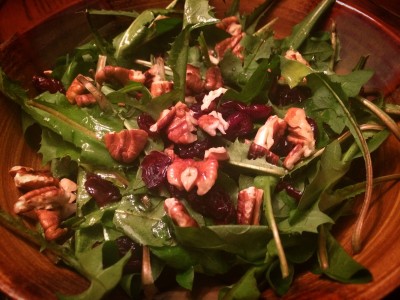A Dandelion Salad
Some months ago, I wrote a flash fiction piece called “A Dandelion Market”. Though it featured a dystopian City of Charlotte, some monster/zombie type folks, and “the end of the world as we know it”, it was really about dandelions and how awesome yet unappreciated they are. I know that most people see them as a nuisance, but dandelions are incredibly hardy plants, bloom beautiful yellow flowers, double as toys for kids ages 2-102, and are edible. Yes, those weeds that you battle summer after summer are actually food for humans. If you look closely, you might even find them at your local farmer’s market, though on first glance you might mistake them for arugula.
Since moving to the city, it has struck me very odd that folks are so bent on eradicating the dandelion from their yards. What did they ever do to hurt you? Now, I do fully understand how quickly they spread, and I get that green uniformity is beautiful in its own way, but do remember that a weed is just a plant growing somewhere you don’t want it to. There’s nothing inherently evil about them – especially if they aren’t poisonous.
Like the main character in my story (Dan), I spend significant time during the summer scratching dandelions out of the front yard and sometimes in the back. But if you are looking for a non-toxic way to control your dandelions, I also have a better solution – Eat them.
No, really, I’m serious. Dandelions are one of the safest survival foods because they are so easy to identify and because every part of a dandelion is edible – flower, leaves, and roots. Dandelions bloom bright yellow flowers individually on leggy stems, and their smooth greens spread out from the root in a star-like pattern. The greens remain close to the ground while flower stems tower over them, even when the plant is mature. You’re familiar with these guys.

Now before you go grab a fistful to make a salad, please do be sure you are grabbing the correct plant. While dandelions are easy to identify, you need to be sure. If you have to ask yourself, ”Is this a dandelion?”, please do not try to gather your dinner. Just go get some dandelions from your local farmers’ market, or get some seed from a reliable dealer and grow them in a flowerbed. (Or consult a local plant expert who can teach you how to accurately identify wild plants in your area.) But if you are adventurous like me, have done your research, and gotten a lesson or two from reliable old timers, get to gathering.
Now please do understand that just because a plant isn’t going to poison you itself doesn’t mean you should eat it. If you’re going to gather dandelions instead of growing them, be smart, and consider the following:
Where is it growing? Plants absorb what is around them. They can’t help it. This is how they get their water and nutrients. If you are going to eat a plant, it needs to come from an area that isn’t contaminated with potential poisons or toxins. Look at the lay of the land. Is the plant growing in a run-off area? If so what is around it? Is it near parked vehicles or shops? Is it growing near railroad ties? Use your brain and don’t gather a plant that could be absorbing contaminated run-off. Do not, I repeat, DO NOT gather dandelions from a yard that is sprayed with herbicides or that is treated with insecticides (aka. treated for mosquitoes, ticks, stinging insects, or the like). Do not gather from a yard if you don’t know whether it is sprayed or not. While it might not hurt you, doing so is asking for trouble. I also don’t gather from the front yard because it is closer to the road.
What is around it? I would hope that if there was a giant dog turd beside your dandelion you would leave it alone. Be sure that the plant is growing in an area that is free of excrement. Animals (both wild and domesticated) carry parasites, and even though we’re going to thoroughly wash our dandelions, it’s best to avoid the crappy ones.
Does the plant look healthy? If the dandelion is splotchy or yellowed or otherwise not green and vibrant, move along. There will be plenty of others to pick from because they are so hardy, and let’s be honest, you’re not doing this for survival. You really could go to the market and get a head of Romain or a tub of arugula if needed.
Have you eaten it before? Just because everyone else can eat it doesn’t mean your body will agree that it’s great. Allergies exist. As with any new food, try a small amount first to see if you have any adverse reaction to it.

So you’ve got your dandelions. What next?
Wash them. Wash. Wash. Wash. I always wash vegetables even if they come out of my garden. You never know what’s rained on them or what’s walked over them. Running water gets rid of most of the microbes that can make you sick. That’s part of why people started living longer when hand washing with running water became the trend in hospitals. You’ll also probably have bits of grass in them from the lawn. Get those out. Then, take a bite. If you gather dandelions throughout the year, you’ll notice they taste differently during different seasons. Dandelions taste similar to arugula. They have a strong, sharp flavor, but it is a little less peppery and a little more bitter. The warmer the weather, the more bitter the greens will likely be.
Now let’s make a Dandelion Salad.
What You’ll Need: dandelion greens, pecans, dried cranberries*, lemon juice, olive oil, salt.
What You Do: Roast your pecans on low in a skillet on the stove. Mix the juice from half a small lemon (or a little less from a larger one – one or two tablespoons depending on how much you want) with equal parts olive oil and a little salt. Whisk it well. You can of course adjust the lemon juice or olive oil based on how acidic you like your dressing. Taste and adjust until you make your tongue dance. Put your dandelion greens in a bowl. Top with roasted pecans and dried cranberries. Dress the salad.

Voila! – a lovely, tasty creation that actually made use of those “weeds” rather than nuking them with poison. There now, isn’t that better?
* I was actually considering using Indian Strawberries, which grow wild my the backyard, on this salad, but as they were out of season, dried cranberries seemed the best substitute – tangy and sweet but not too sweet. Perhaps, I’ll try the strawberries next spring.
Leave a Reply